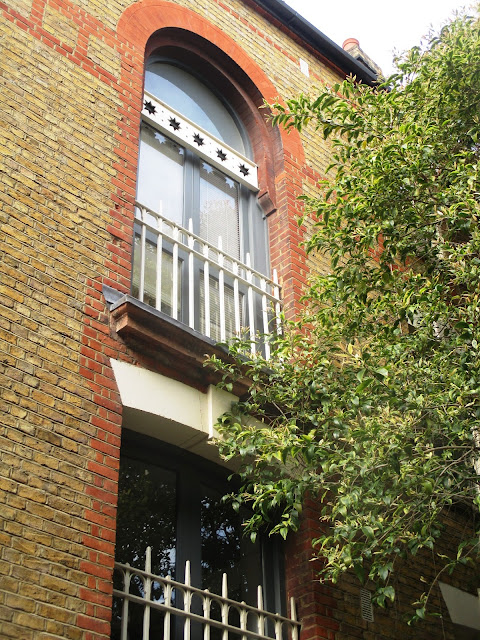I was down in London to see some Liberator friends yesterday, and took the chance to visit Chess and Bridge in Baker Street. (Yes, I'm getting hooked on chess again.)
After that I explored Marylebone and, because I've never thought of it as a poor area, was surprised to come across nine blocks of 19th-century "improved dwellings". These were early essays in social housing, provided in slum areas of London.
And West of Marylebone High Street, a draft chapter of University College London's survey of South East Marylebone, tells me all about them:
Most of the Grotto Passage area was redeveloped with blocks of improved dwellings from the late nineteenth century, leaving the old essentially pedestrian street layout. The process began with what is now 8 Garbutt Place, built privately in 1881 in the normal course of lease renewal.
But the major campaign was over a 15-month period in 1888–9, when some 100 workmen were engaged by Wall Brothers of Kentish Town in building the first seven blocks of Ossington Buildings, on the sites of Conway and Grafton Courts, together with a communal steam laundry in a separate building. Initially called the Portland Industrial Dwellings, these were swiftly renamed in honour of the aged Lady Ossington, co-owner of the Portland estate, though strictly speaking the new name applied only to the north–south street formerly called Grafton Court.
Two further blocks, on the east side of Grotto Passage, replacing Harrison’s Place, followed shortly after; they were tendered for by Walls, who lost out to Staines & Son.
The nine blocks, of four storeys plus basements, were the joint work of the architects Alfred Robert Pite and Charles Fowler, the estate surveyor. Although wellbuilt, with fireproof floors and artificial stone staircases, they provided only the most basic accommodation and were at first let by the room, almost all the rooms being fitted with stoves or small ranges. Water and two WC’s were provided on each landing.
The blocks of Ossington Buildings were modernised long ago, but it doesn't surprise me to learn that the facilities here were originally very basic.
In The Yellow Balloon, one of my children-and-bombites-in-postwar-London films, Andrew Ray and his parents live in similar accommodation - one of the blocks on Chelsea's Sutton Estate.
Looking for something good to do before he asks his mother for sixpence, the young Ray lugs a pail of water up the stairs from the half-landing below.
Anyway, here are some photographs from yesterday. If you want to know more about this quarter of Marylebone, The Gentle Author was there long before me.
Oh, and the monogram over the door is PIDC, standing for Portland Industrial Dwellings Company.





8 comments:
The block is (or was in the 1990'sl) owned by the Howard de Walden Estate who own the area around Marylebone High Street. I worked there for a while and instigated the scheme for the new(er) adjacent flats. My memory is that Osmington was 4% philanthropy down to the late Lord HdeW's grandmother, or something like that.
I think one can be reasonably confident that the de Walden estate still owns the land in Marylebone. The major landowners of Central London do buy and sell, but it's not a particularly dynamic picture over time. There's an excellent account of the major landowners here:
https://whoownsengland.org/2017/10/28/who-owns-central-london/
I lived in a flat in one of the blocks for 6 months in the late 1980s. It was an amazing place to live, good sized rooms, a flat roof with views over London and space to hang your washing. I walked to my job on Oxford Street every day.
I lived in the Charles Fowler House Ossington Building in 2019 as a student and absolutely loved it! I considered it glamorous - it always felt safe and, although basic still, I am amazed to read here about its original purpose, thank you!
I live in NZ and came across this site by pure chance. Looking up Grafton Court. My paternal 2xgreat grandfather lived there in the 1830s he was a chimney sweep kid all of 10 years old with his chimney sweep master. Fascinating. We think we have it tough today.
That would have been M Block as it was the only block with a flat roof. In summer months that roof was almost melting! I lived there in the 60's and 70's and although we had indoor water the toilets were still outside. Very unsettling in the dark when the lights were off! 😳
My mother lived there as a child in the mid to late 1920s. they had two rooms across the hall from each other. there were 3 children mother and father. My grandfather had a baby grand believe it or not and when he used to play all the neighbours used to leave there doors open to listen. My mother and her sister became residents of the nearby girls convent school until leaving at 14 years old. By that time my grandfather had become a member of the horse-guards in India and separated from my granny who refused to move there.
During the war my granny and her two daughters rented a house in Camden Town.
All my grannies children became successful people including my beautiful mother.
Life moves on.
Sorry their and granny's should have been the words.
Post a Comment